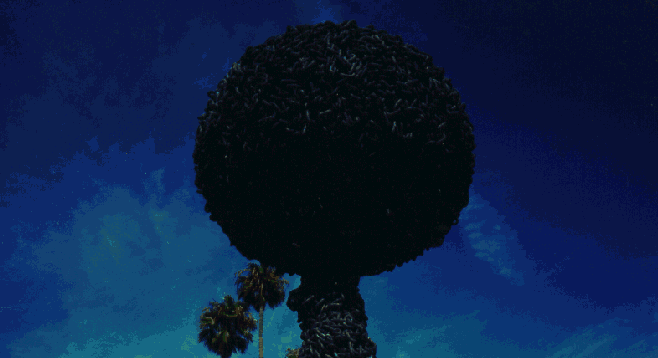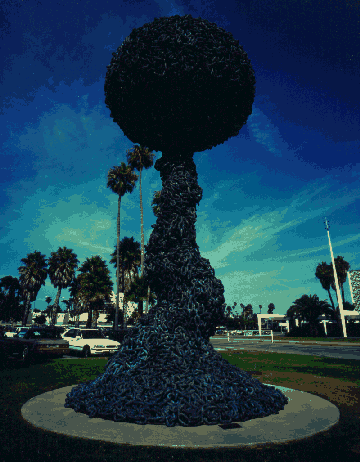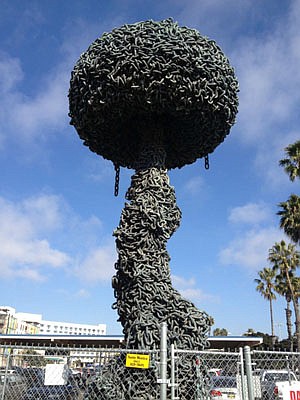 Facebook
Facebook
 X
X
 Instagram
Instagram
 TikTok
TikTok
 Youtube
Youtube

On October 12th, it will have been ten years since Joan Kroc’s passing. Despite that, it’s nigh impossible to spend a day in San Diego without encountering some dedication to the late fast food heiress’ legacy of philanthropy. The enormous bequests she made, especially as she neared the end of her life, still sustain public arts and service institutions here and elsewhere.
It was Kroc’s support of political cartoonist and sculptor, Paul Conrad, that allowed the controversial artist to erect “Chain Reaction,” his monumental indictment of nuclear proliferation, at the Santa Monica Civic Center. Kroc, being quite the peacenik, anonymously donated the $250,000 to fund the statue’s construction in 1991. After two decades, the city of Santa Monica is keen to remove the 26-foot-tall structure, citing safety issues and an alleged $400,000 repair bill as the primary causes.

Critics have called the city’s position on the matter dubious. Christopher Knight at the LA Times implies that there may be an underhanded bid to remove the sculpture simply because someone in power doesn’t like it. Whatever the reason, the city of Santa Monica isn’t rushing to refurbish the statue, and it has fallen to private citizens to raise money for its repair. Dave Conrad, Paul Conrad’s son, is heading up efforts to save “Chain Reaction.”
“We’ve raised about $35,000 from local artists and donors,” says Conrad, “and we’re hoping to get larger donations from foundations and other major donors.”
Initially, Conrad tried to tap into the philanthropic legacy of Joan Kroc. He thought that since Kroc had been so generous in funding “Chain Reaction”’s construction, memory of her involvement might open fundraising doors. But, as he found out, there isn’t any money left.

Because Joan Kroc did not set up any permanent trusts or foundations to distribute her wealth in perpetuity, the epic donations that she made in her final years represented the end of her giving. There was a rhyme and a reason for doing so, of course. Her money could be used for immediate good, rather than sitting still, suffering the attrition of inflation, and being used to provide for its own care in a curiously self-sustaining cycle.
Her approach to giving had its merits. But, like anything else, there are disadvantages. Chief among them is that the money is gone when it’s gone. There will be no more gifts.
More than anything else, it’s a testament to the size of Joan Kroc’s generosity that it has taken a full ten years for her absence to be felt. Were Kroc still with us, there’s little doubt she would let “Chain Reaction” come to any harm. Now, a full decade after her final gifts were made, the effects of her philanthropy are beginning to wane.
Many of the billions of dollars that Joan Kroc gave away during her lifetime are still in use today, and will sustain her legacy for years to come. But the threat to “Chain Reaction” is a visible reminder that even the most generous patronage doesn’t last forever, though the world is fortunate to have received it.


On October 12th, it will have been ten years since Joan Kroc’s passing. Despite that, it’s nigh impossible to spend a day in San Diego without encountering some dedication to the late fast food heiress’ legacy of philanthropy. The enormous bequests she made, especially as she neared the end of her life, still sustain public arts and service institutions here and elsewhere.
It was Kroc’s support of political cartoonist and sculptor, Paul Conrad, that allowed the controversial artist to erect “Chain Reaction,” his monumental indictment of nuclear proliferation, at the Santa Monica Civic Center. Kroc, being quite the peacenik, anonymously donated the $250,000 to fund the statue’s construction in 1991. After two decades, the city of Santa Monica is keen to remove the 26-foot-tall structure, citing safety issues and an alleged $400,000 repair bill as the primary causes.

Critics have called the city’s position on the matter dubious. Christopher Knight at the LA Times implies that there may be an underhanded bid to remove the sculpture simply because someone in power doesn’t like it. Whatever the reason, the city of Santa Monica isn’t rushing to refurbish the statue, and it has fallen to private citizens to raise money for its repair. Dave Conrad, Paul Conrad’s son, is heading up efforts to save “Chain Reaction.”
“We’ve raised about $35,000 from local artists and donors,” says Conrad, “and we’re hoping to get larger donations from foundations and other major donors.”
Initially, Conrad tried to tap into the philanthropic legacy of Joan Kroc. He thought that since Kroc had been so generous in funding “Chain Reaction”’s construction, memory of her involvement might open fundraising doors. But, as he found out, there isn’t any money left.

Because Joan Kroc did not set up any permanent trusts or foundations to distribute her wealth in perpetuity, the epic donations that she made in her final years represented the end of her giving. There was a rhyme and a reason for doing so, of course. Her money could be used for immediate good, rather than sitting still, suffering the attrition of inflation, and being used to provide for its own care in a curiously self-sustaining cycle.
Her approach to giving had its merits. But, like anything else, there are disadvantages. Chief among them is that the money is gone when it’s gone. There will be no more gifts.
More than anything else, it’s a testament to the size of Joan Kroc’s generosity that it has taken a full ten years for her absence to be felt. Were Kroc still with us, there’s little doubt she would let “Chain Reaction” come to any harm. Now, a full decade after her final gifts were made, the effects of her philanthropy are beginning to wane.
Many of the billions of dollars that Joan Kroc gave away during her lifetime are still in use today, and will sustain her legacy for years to come. But the threat to “Chain Reaction” is a visible reminder that even the most generous patronage doesn’t last forever, though the world is fortunate to have received it.
Comments